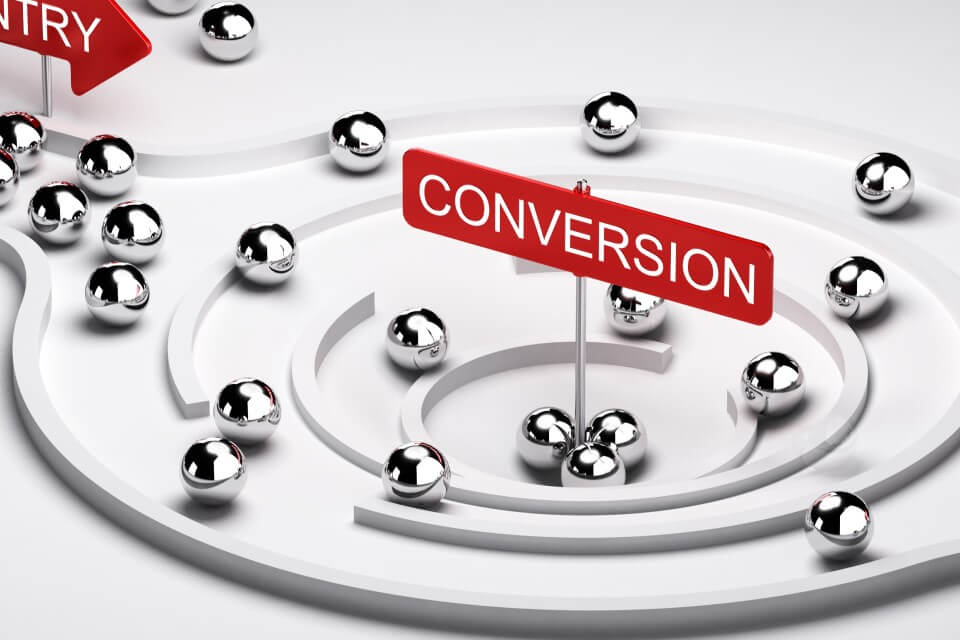How well does your website convert? How many leads do you drive to your sales pages every day? Most marketing plans today build strategies for driving traffic. But that’s only half the battle.
A million vegetarians driven to a landing page selling steaks won’t be successful at selling. What it takes is finding the right prospects and customers, speaking their language, and improving your chances of a sale.
The best way to do that is with a conversion rate optimization strategy. It can help you understand your website’s usability and how your customers are interacting. Conversion rate optimization provides more qualified leads, increases your revenue, and lowers your acquisition costs.
What Is Conversion Rate?
A conversion rate is the percentage of visitors who complete the desired action. It can be as simple as signing up for a free newsletter or purchasing a product.
The higher the conversion rate, the more effective the process. If it’s appealing to your visitors, they take action as designed for them. Of course, nothing is perfect. One-hundred percent success is difficult at best. Many things can slow down the process:
- A broken form
- Slow load times
- Copy that doesn’t convert
- A poorly designed page
- The wrong message
A “good” conversion rate depends on a variety of things: your industry, your niche, your demographics, your local area, your channel. A “good” conversion rate can change by industry and change from day to day. Statistics show for ecommerce sites, it hovers between 2 to 3 percent globally.
How do you find yours? First, determine what conversion rate you’re defining. Maybe it’s how many people are signing up for your newsletter. Divide the total number of newsletter subscribers by the total number of website visitors and multiply it by 100. If you had 200 new subscribers last month, with 10,000 visitors, that would leave you with a conversion rate of 2 percent (200 / 10,000 x 100).
What Is Conversion Rate Optimization?
Now that you have your conversion rate, you have what you need to focus on optimization. In the above example, how could you increase your sign-up rate to 2.1 percent? To 2.2 percent? Every step you take to make a difference in the eyes of your lead pool, ask what you can do to make it a little bit better.
Dig Deeper
5 Most-Asked Questions About Target Marketing Strategies
Using Your Mobile Customers As Your Focus Group
Conversion rate optimization takes place on many different elements of your online experience. It’s a process of analyzing the data, testing various elements, tweaking the process, and doing it all one more time.
1. Home Page
Your website’s home page is the most obvious place to start. This is where many visitors make their first impression of your business. They use this as a guide to further access and learn about what you do.
You can optimize your conversion rate here by giving your visitors logical choices. Have free information boxes highlighted. Use chat boxes to start conversations. Emphasize links to specific products and services. Focus in on what your customer wants.
2. Landing Page
For many of the sales tactics you use online, you direct traffic to a landing page, not your home page. These landing pages are specific to your ad campaign and what you’re trying to accomplish. Landing pages are designed to take action, so they are easier to optimize for results.
Design each landing page with a specific target in mind. Then optimize it to get your desired results. You can use a variety of optimization techniques, including color, placement, copy, graphics, and more.
3. Copy
If you’ve ever read a poorly written article, you know how important good copy is. While people start by assessing a page’s visual appeal, once they dive in, it should be able to verbally hook the reader and make them want more.
Optimization comes from making the page visually appealing. Use headlines to capture attention. Leave plenty of white space to ensure it doesn’t overwhelm. Use a font type that makes it easy to read. Write to speak directly to your target audience.
Writing isn’t about you. Your purpose isn’t to sell, sell, sell. Always write from the point of the visitor. Why are they on a specific page? Give them exactly what they want and they’re more likely to stick around.
4. Blog
Blogs have become synonymous with website development. But there is a massive conversion opportunity in using your blog to its fullest potential, something many site owners forget. You can produce thoughtful content specifically targeted to your audience. You can also use call-to-action strategies that lead hungry buyers directly to the sales page.
This is your best strategy for adding content online. If you haven’t carefully crafted a blog content strategy, you’re missing out on the chance to increase your conversion rates and connect on a deeper level with your audience.
5. Call to Action
You know what you’re selling. Does your visitor? A call to action is precisely what it sounds like—a mechanism used to get your visitor to take action. It could be to click on a link, sign up for a free report, or buy a product. Hide this or make the concept obscure, and you’ll decrease your conversion rate.
To optimize it, start looking at the psychology behind what makes people click. What makes them say yes? Make buttons bigger. Change colors. Add visual appeal. Change the copy. Increase the size of the text. There are unlimited things you can do.
6. Navigation
What makes sense to you might be confusing to your customers. We all want to be “different” or stand out from the crowd. Yet your visitors have preconceived notions about placement and how to click. Confuse them with concepts they don’t understand, and they’ll move on.
This is where it helps to have a second pair of eyes. Utilize help outside of your business to see where your weakest points are. What confuses visitors? Where do they leave your site? Focus on these areas to make a more fluid flow as you move throughout your site.
Are You Using Conversion Rate Optimization for Your Online Presence?
There are many best practices to ensure you’re optimizing your conversions. If you haven’t spent time analyzing how well your pages are doing, maybe it’s time you did.
How can you increase conversions this month for everything you do?
Need a little help? Give us a call today.




